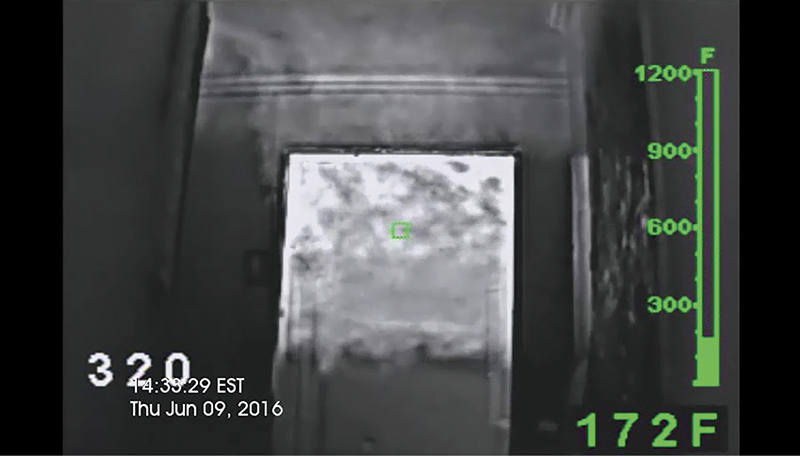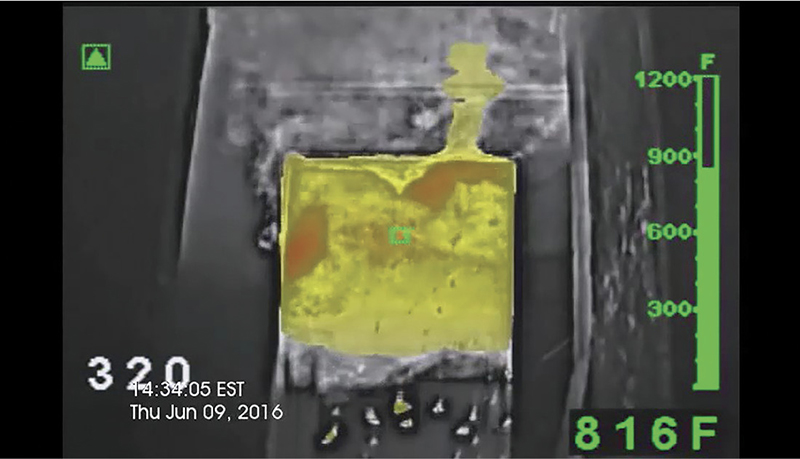Last month, I wrote about thermal imaging limitations because although it is an extremely useful tool for the fire service, it does have limitations that every user should be aware of.
This month, we are going to focus on the benefits of using a thermal imager (TI) for the fire service.

1 The early stages of fire progression.

2 The advanced stages of fire progression. (Photos courtesy of Bullard.)
- Enhanced Situational Awareness: A TI allows firefighters to see through smoke, darkness, and low-visibility conditions. It helps identify hot spots, hidden fires, and potential dangers, thereby enhancing situational awareness.
- Increased Safety: For interior operations using a TI, firefighters can navigate hazardous environments more safely. It helps them identify structural weaknesses and black holes, locating victims, and evaluate potential escape routes, reducing the risk of injury or death. For exterior operations using a TI, firefighters can detect down power lines and other potential hazards at a motor vehicle incident.
- Efficient Search and Rescue: TIs can quickly locate and prioritize victims in search and rescue operations and even in environments with limited visibility. This saves precious time and increases the chances of successful rescues. A victim’s image could appear as white, gray, or dark depending on the environment. In a room where the surface temperature and skin temperature are the same, the victim might not be seen with the TI. Scan slowly and look carefully.
- Effective Fire Suppression: TIs assist in accurately locating the seat of the fire and determining its size and intensity. This information enables firefighters to develop effective strategies for extinguishing the fire promptly and efficiently.
- Rekindle Prevention: After the initial suppression, TIs can be used to detect any remaining hot spots or hidden pockets of fire. This helps prevent rekindling and ensures that the fire is fully extinguished, resulting in due diligence on the fire department’s behalf.
- Efficient Ventilation: Understanding the flow of heat and smoke is crucial for effective ventilation tactics. TIs can help identify areas where ventilation openings are most needed, optimizing the efficiency of these operations. The TI operator must understand the difference between conducted heat from the interior fire and heat absorbed from the sun (solar loading). The same should be understood about a vent showing heat from a fire vs. heat from the building’s heating system.
- Training and Education: TIs are valuable tools for training firefighters. They enable trainees to learn how fire behaves, understand thermal patterns, and simulate various scenarios in a controlled environment, promoting learning and skill development. A TI can also show fire apparatus operators overheated pumps when water is not properly recirculated.
- Apparatus Placement: TIs can help with aerial apparatus placement during limited visibility conditions to identify hazards such as overhead power lines.
- Stream Placement: TIs can aid in the positioning of interior attack lines and exterior master streams when firefighters have limited visibility because of smoky conditions.
- Accountability: TIs are an excellent tool for accountability, reducing the time it takes to account for firefighters during emergency situations. TI operators should understand a false image could be displayed because of reflections. TIs account for the correct number of firefighters but do not account for the correct firefighters assigned to a sector or division.
- Rehabilitation: TIs can be used by safety or accountability officers to compare firefighters doing the same job or task. They should be the same shade. An overheated firefighter would show up whiter than other firefighters, which is called “White Hat Syndrome.”
- Hazardous Materials: TIs can be used to determine tank liquid levels, vapor spaces, and vapor releases. The TI operator should understand insulated tanks and double-walled tanks will not show product levels or vapor spaces. Tanks or vessels that have just had material removed or added might not show an accurate product level or vapor space. Give it some time to stabilize and check again.
On your next emergency response, think about what the benefit will be when you use the TI and how it will enhance firefighter safety, improve operational efficiency, and increase the effectiveness of firefighting efforts.
MANFRED KIHN is a 19-year veteran of the fire service, having served as an ambulance officer, emergency services specialist, firefighter, captain, and fire chief. He has been a member of Bullard’s Emergency Responder team since 2005 and is the company’s fire training specialist for thermal imaging technology. He is certified through the Law Enforcement Thermographers’ Association (LETA) as a thermal imaging instructor and is a recipient of the Ontario Medal for Firefighters Bravery. If you have questions about thermal imaging, e-mail him at Manfred_kihn@bullard.com.

